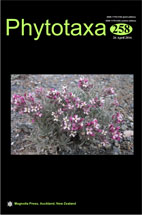Abstract
Although dysploidy and polyploidisation events are known to be important drivers in the evolutionary history of the genus Crocus, only a few examples of natural hybrid origins have so far been documented. Here, we describe the phylogenetic affinities of five taxa in the Crocus vernus species complex from the Carpathian Basin in Central Europe. Genetic variability was evaluated using chloroplast DNA sequences of the accD-psaI intergenic spacer and amplified fragment length polymorphism (AFLP) in combination with karyological observations. Genetic diversity and differentiation of the seven investigated Crocus species were also evaluated using AFLP data. We created a phylogenetic hypothesis using both sequences and AFLP fingerprinting data under maximum parsimony (MP). AFLPs were also analysed by means of multivariate statistics using principal coordinate (PCoA) analysis and Bayesian clustering (BC) to test for hybridity. Both the AFLP and plastid phylogenetic trees separated the taxa into two groups: (1) a ‘Balkan’ clade, and; (2) an ‘Adriatic’ clade. The Balkan clade contained Crocus heuffelianus samples and one Crocus vittatus from Croatia as well as Crocus tommasinianus samples from Hungary; the Adriatic clade included Crocus vittatus and Crocus vernus samples from Hungary and Croatia as well as Crocus neapolitanus from Italy. A hard incongruence was found in the placement of the Slovakian Crocus scepusiensis which clustered inside the Balkan clade on our plastid tree, while it fell in the Adriatic clade on the AFLP tree. The same populations occupied intermediate position on the PCoA plot. The BC analysis assigned all Crocus scepusiensis specimens as F1 hybrids, while Crocus vernus and Crocus heuffelianus were assigned as parental species. Together with our cytological investigation that determined a 2n=18 chromosome number of Crocus scepusiensis, we conclude an allopolyploid hybrid origin for this Northern Carpathian taxon as the result of a cross between members of the 2n=10 Balkan clade (e.g., Crocus heuffelianus from Transylvania) and the 2n=8 Adriatic clade (Crocus vernus). A similar origin is postulated for the North Balkan Crocus vittatus (2n=18), which was clustered as an F1 hybrid in the BC analysis; thus, parallel evolution may have taken place in the northern and southern part of the Carpathian Basin beginning from the same parental species but leading to different allopolyploid derivatives.

